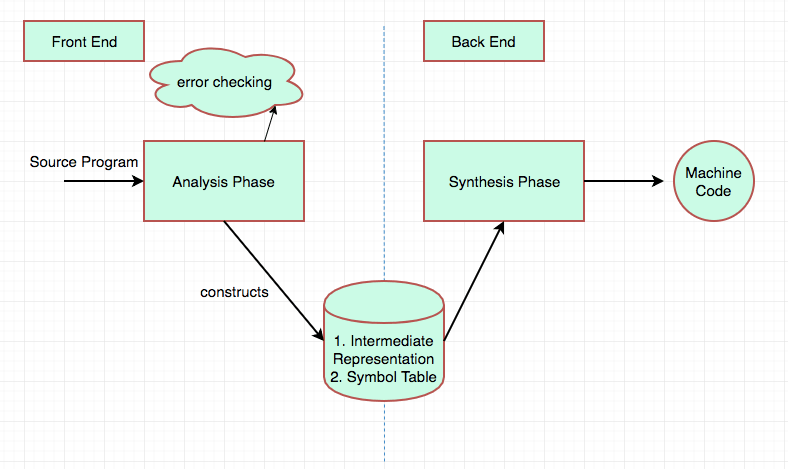Compiler:Analysis_Synthesis Model
We basically have two phases of compilers, namely the Analysis phase and Synthesis phase. The analysis phase creates an intermediate representation from the given source code. The synthesis phase creates an equivalent target program from the intermediate representation.
Analysis phase of compiler
Analysis phase reads the source program and splits it into multiple tokens and constructs the intermediate representation of the source program.
And also checks and indicates the syntax and semantic errors of a source program.
It collects information about the source program and prepares the symbol table. Symbol table will be used all over the compilation process.
This is also called as the front end of a compiler.
Synthesis phase of compiler
It will get the analysis phase input(intermediate representation and symbol table) and produces the targeted machine level code.
This is also called as the back end of a compiler.

Analysis of the source program The structure of source program can be analyzed in 3 levels which are, 1. Lexical analysis/ linear analysis/ scanning 2. Syntax analysis/ hierarchical analysis/ parsing 3. Semantic analysis Lexical analysis This is the lowest level.
The compilation process is a sequence of various phases. Each phase takes input from its previous stage, has its own representation of source program, and feeds its output to the next phase of the compiler. Let us understand the phases of a compiler.
Lexical Analysis
The first phase of scanner works as a text scanner. This phase scans the source code as a stream of characters and converts it into meaningful lexemes. Lexical analyzer represents these lexemes in the form of tokens as:
<token-name, attribute-value>
Syntax Analysis
The next phase is called the syntax analysis or parsing. It takes the token produced by lexical analysis as input and generates a parse tree (or syntax tree). In this phase, token arrangements are checked against the source code grammar, i.e. the parser checks if the expression made by the tokens is syntactically correct.
Semantic Analysis
Semantic analysis checks whether the parse tree constructed follows the rules of language. For example, assignment of values is between compatible data types, and adding string to an integer. Also, the semantic analyzer keeps track of identifiers, their types and expressions; whether identifiers are declared before use or not etc. The semantic analyzer produces an annotated syntax tree as an output.
Intermediate Code Generation
After semantic analysis the compiler generates an intermediate code of the source code for the target machine. It represents a program for some abstract machine. It is in between the high-level language and the machine language. This intermediate code should be generated in such a way that it makes it easier to be translated into the target machine code.
Code Optimization
The next phase does code optimization of the intermediate code. Optimization can be assumed as something that removes unnecessary code lines, and arranges the sequence of statements in order to speed up the program execution without wasting resources (CPU, memory).
Code Generation
In this phase, the code generator takes the optimized representation of the intermediate code and maps it to the target machine language. The code generator translates the intermediate code into a sequence of (generally) re-locatable machine code. Sequence of instructions of machine code performs the task as the intermediate code would do.
Symbol Table
It is a data-structure maintained throughout all the phases of a compiler. All the identifier's names along with their types are stored here. The symbol table makes it easier for the compiler to quickly search the identifier record and retrieve it. The symbol table is also used for scope management.


You must be logged in to post a comment.